How much is not having to buy gas worth to you?
That question can be answered by comparing the VW ID.4 electric crossover with VW’s two otherwise similar small crossovers, the Tiguan and Taos – neither of which is electric.
And for that reason cost about $12-$15k less to start – and come standard with twice as much range.
On the other hand, they’re not electric – and you can’t fuel them up at home.
And that may be worth less to you.
The ID.4 is a compact-sized, two-row (five passenger) electric crossover that’s a few inches longer on the outside than a Taos – and not quite as long on the outside as the Tiguan.
Which is a bit smaller – in terms of cargo space – on the inside.
The ID.4 is also electric – and it’s the only rear-wheel-drive crossover (or otherwise) VW sells. The base trim comes standard 208 miles of range and stickers for $38,995 to start.
This version of the ID.4 comes only in the rear-drive layout.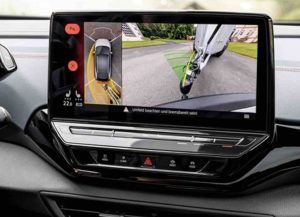
The Pro gets you a stronger battery and more range (275 miles) plus AWD is available. But it knocks 20 miles off the VW’s range.
A top-of-the-line Pro S with AWD and 255 miles of range lists for $55,295.
What’s New for 2023
In order to make the ID.4 more affordable, VW has lowered the base price of its little electric crossover by $2,240 vs. last year. The catch is the price cut costs range. Last year’s $41,235 base trim ID.4 came standard with 250 miles of range.
A larger (12 inch) centrally mounted touchscreen is now standard in all trims.
What’s Good
Costs less (to start) than it did.
More room inside than in the Tiggy – and bigger on the outside than a Taos.
A bargain compared with a Tesla Model Y ($49,990 to start; $52,990 with its optional, “long range” battery).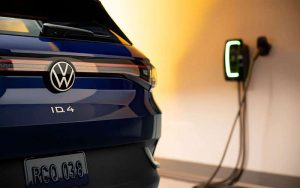
What’s Not So Good
It still costs almost $40k to start – which is a lot for a small crossover.
Base battery’d model isn’t especially quick – and doesn’t go very far.
AWD equipped models are quicker – but don’t go much farther, either.
Under the Floorpans
The base rear-drive ID.4 has a new, less powerful 58 kilowatt-hour battery pack that costs less – but also costs you range, which is just 208 miles now. Best case. The latter in italics to emphasize that, with battery-powered cars, the actual range you can drive is often less than the indicated range in the dash display.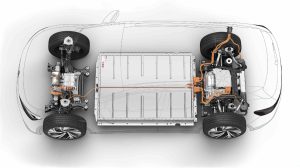
Cold weather, for example, can (and will) reduce the distance you can actually drive because of the power consumed keeping you (and the battery) warm in the cold. When it’s warm and you want to stay cool, use of the AC will draw power – and cost range.
Remember that in an electric car, everything is electrically powered. Including the heater (and AC) for the cabin and the heating (and cooling) system for the battery, which has to be kept within a certain range of temperature at all times in order to avoid damaging it and so that it can be charged up in the cold, too.
That’s why it’s nice to have more range – so as to have more of a margin.
VW offers that with the Pro trim – which can go as far as 275 miles. But you’ll pay $5,000 more for the additional range. And if you buy AWD – which comes with a second motor driving the front wheels – you lose 20 miles of that margin.
So equipped, the VW’s range slips to 255 miles.
Also: AWD isn’t available with the lower-performance (and lower cost) 58 kilowatt-hour battery that comes in the base trim, which is RWD only.
Almost every other crossover on the market (including the Taos and Tiggy) are front-wheel-drive/AWD, which they are because that’s generally what people who buy crossovers want. The rear-drive layout (engine up front, light in the tail) is a kind of anomaly in the crossover class generally – because it’s not the optimum layout for snow-day driving. A FWD crossover with the right tires can be a great snow-day vehicle.
More to the point, you can skip paying extra for AWD and still not get stuck when it snows.
But – don’t worry too much. The rear-drive ID.4 should be ok in the snow because – like the old VW Beetle – the engine (well, the electric motor) is rear-mounted and that puts the weight of the engine over the drive wheels, enhancing traction. Most rear-drive vehicles are front-engined vehicles and so light in the rear, which is why they are generally slippery in the snow (and the wet).
With the standard battery/single motor set-up and the EV equivalent of 201 horsepower, the ID.4 gets to 60 MPH in about 7.5 seconds, which is slow for an EV but slightly quicker than otherwise similar non-electric crossovers like the Tiggy, which makes the same run in just over 8 seconds.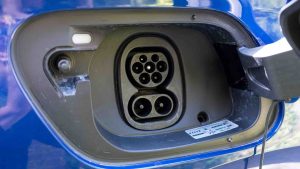
Things happen quicker with the optional, larger battery pack and the EV equivalent of 295 horsepower. So equipped, the ID.4’s zero to 60 times falls to just over 5 seconds, a speedy time as such but even more impressive given the 4,300 lbs. this small crossover weighs.
Like other EVs, you can recharge the ID.4’s battery pack at home using either standard 120V (Level 1) or 240V (Level 2) charging, with the latter taking about 7.5 hours to fully recharge. Be aware that it takes much longer to charge using 120V (Level 1) and that most homes built before the last two or three years are not likely to have a 240 hook-up in the garage.
Many homes do have a 240V outlet – inside the house – for a clothes dryer or electric stovetop. But that’s probably not close enough to reach – and you’d have to unplug your dryer or stove to be able to plug in your EV.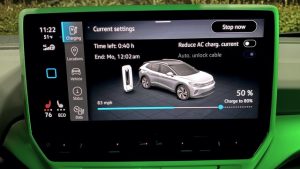
If you don’t have a 240V outlet in your garage – or close enough to plug your EV into – you will probably need to have an electrician come to your home and wire one up. The cost for that can be as little as a couple hundred bucks – and as much as $1,000 (or more) bucks, if the panel needs to be updated.
You’ll also need to have a garage – and that generally means a single family home. You can’t add a 240V line to an apartment you rent – and it’s hard to run an extension cord from there to wherever you parked, on the street.
Also be aware that you cannot “fast” charge an EV at home – because private residences generally do not have the ability to do that.
On The Road
With the dual motor drivetrain (and stronger battery pack) the ID.4 is capable of impressive burst of instantaneous acceleration. There’s an old story about the race car legend Carroll Shelby putting a $100 bill on the dashboard of the AC Cobra that carried his name, telling the person riding shotgun it was his if he could grab it. And then he’d punch it.
No one ever collected the $100.
The ID.4 is like that, except it’s not a high-strung, two-seat race car. It’s a family crossover.
But the catch is that making use of the latent potency it possesses will rapidly sap whatever charge you’ve got left. Just the same as watching the needle move toward empty in a “gas hog” like the Shelby Cobra, with the difference being that it takes a lot more time to put electricity back into an energy hog EV.
This use it and lose it business is one of the unresolved paradoxes of EVs, especially ones like the ID.4 that are – ostensibly – not meant to be race cars. Why then the emphasis on quickness-capability?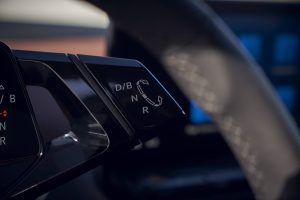
Why, to take your mind off how far you can’t go – and how much it costs.
To get an EV to go even half as far as an otherwise comparably-sized vehicle takes a very large (and very heavy) battery pack, because it takes one of those to store even half the electric-power equivalent of about half a tank of gas (around 7-8 gallons). That’s just physics and chemistry – and until it changes, EVs will necessarily need big and heavy (and expensive) batteries to be able to even approximate the range of a non-electric equivalent.
This would not be a big deal, even so – were it possible to recharge an EV in the same time it takes to refuel. Well, it’d still mean more stops. And having to stop every other day for even a 5 minute charge vs. once a week for 5 minutes for a full tank would still cost time – but it might be manageable. But having to stop – and wait – for 30 minutes or even 15 every other day is not a strong selling point when you can still buy an otherwise similar vehicle that has twice the range, costs a third less and only makes you wait for a few minutes to refuel to full.
And so – look how quick it is!
But then see how much it costs.
VW tried to address the latter this year by lowering what it costs – but that costs a lot of range, as well as quickness.
This is not to say the ID.4 is a bad vehicle. Not in terms of how it drives, which is silent and smoothly – as well as quickly. The problem – for VW and for most of us – is that $40k is a lot to spend to go maybe 208 miles in between stops. It’s also a lot to spend, period – when you can still spend $15k less to be able to go close to 500 miles in between stops.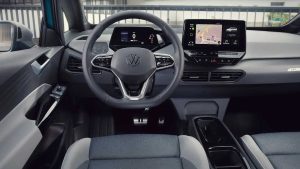
At The Curb
VW chose to go with conventionally crossover exterior styling, which is a plus if you don’t want to make a big deal about driving an electric car, which can be a plus given the politics (ask people who drove a Prius back when it looked like what it was – and what everything else wasn’t).
It’s inside where you’ll see the differences – and use them, too.
For example, the way you engage Reverse or Drive is by rotating the top right section of the main LCD instrument cluster that “floats” on top of the steering column. Backward (toward you) to get Reverse, forward to get Drive. This eliminates center console clutter and also makes sense – even for a non-EV – because in most new vehicles, the transmission’s ranges are engaged via-drive-by-wire rather than by cables. Of course, the ID.4 (like most EVs) has no transmission, so all you’re doing is changing the direction the motors turn.
For Park, push the button located on the side of the section of the instrument cluster you rotated for Reverse and Drive.
Almost everything else is controlled via the second, larger LCD touchscreen off to your right.
The layout is minimalist, which is interesting in that in this one respect, EVs are a kind of throwback to what basic cars were like 50 years ago – when you got a speedometer, a gas gauge and not much else. Of course, an EV does not need much else – such as the tachometer, oil pressure, water temp and other gauges you got with fancier cars back in the day (and that becomes standard in most cars by the mid-1990s).
The things you might want to monitor – such as use of power (and adjust, so as to use less) can be found by tapping and swiping through the menus in the center console display. One of these is the climate control system, which can be optimized to use as less electricity – remember, everything that’s powered in an EV is powered by electricity – but this reduces cooling (and heating) performance for the sake of not burning up range.
It’s an EV Catch-22 to be aware of.
In terms of the physicalities:
The ID.4 is 180.5 inches long, which puts it in-between the compact-sized Tiggy (186.1 inches) and the Taos (175.8 inches) in terms of its footprint. Some reviewers have praised the ID.4 for having more space available for cargo behind its second row (and with those seats up) than the larger-footprint Tiggy does – and this is true.
The ID.4’s got 30.3 cubic feet of cargo behind its second row vs. just 12 in the Tiggy.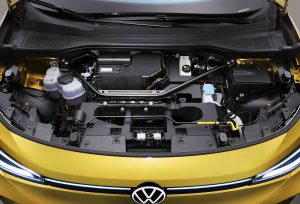
However, the Tiggy has about the same total cargo capacity – 65.3 cubic feet vs. 64.2 for the ID.4 and the Taos – which has a smaller overall footprint – has about the same capacity 27.9 cubic feet) behind its second row and slightly more total cargo space (65.9 cubic feet) when you fold them down.
Relative to other small electric crossovers in the class, it’s a draw. The Ford Mustang Mach e has 34 cubic feet of space behind its second row and 64.4 cubic feet of total cargo carrying capacity. The Tesla Model Y has 34.3 cubic feet of space behind its second row and 76.2 cubic feet if total capacity.
The Rest
Interestingly. the ID.4 has no “frunk” – or trunk, up front – if you buy the dual-motor/AWD version. The second motor takes up the space. Also, there’s no 12V power point, so you can’t plug in accessories that use that kind of interface without an adapter.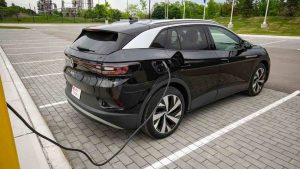
The Bottom Line
The ID.4’s main draw is probably its low price – for an EV, relative to other EVs in the class such as the $42,995 to start Mustang Mach e and the $52,990 to start Tesla Model Y. And especially relative to the new (and $43,190 to start) Nissan Ariya and Kia EV6 ($48,700 to start). Neither of the latter two go much farther, either. The Ariya’s standard range is 216 miles; the Kia’s EV6’s is a not-much-better 232 miles.
The problem – for all of them – is none of them go very far as they come. You have to pay thousands more for a little more range – and even then, you haven’t got much. That means more time spent charging, to get it back.
But at least with the VW, you’ll be spending less money.
. . .
If you like what you’ve found here please consider supporting EPautos.
We depend on you to keep the wheels turning!
Our donate button is here.
If you prefer not to use PayPal, our mailing address is:
EPautos
721 Hummingbird Lane SE
Copper Hill, VA 24079
PS: Get an EPautos magnet or sticker or coaster in return for a $20 or more one-time donation or a $10 or more monthly recurring donation. (Please be sure to tell us you want a magnet or sticker or coaster – and also, provide an address, so we know where to mail the thing!)
My eBook about car buying (new and used) is also available for your favorite price – free! Click here. If that fails, email me at EPeters952@yahoo.com and I will send you a copy directly!


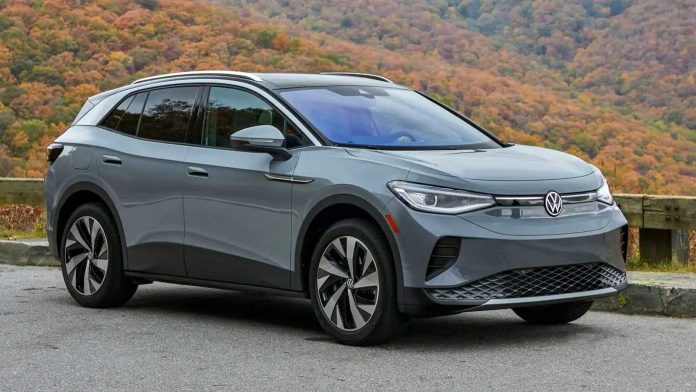

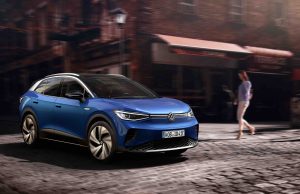
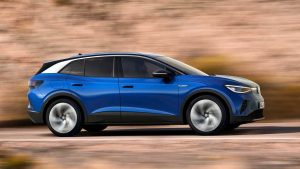
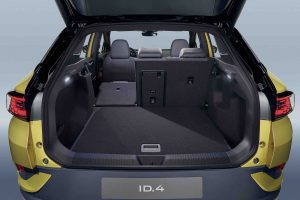








A tad late, perhaps, but any expectation of Ford’s version of this device being in anyway significantly “different,” Eric? Same skateboard, different sticker?
Eric – it must be getting harder and harder to be a car journalist when you get more and more of these…. What do you even write !?!? May well review a washing machine…
Infact I thought of something – see if you can screech tires at a green light !! (if the computer even allows it!)
With all the liabilities it’s hard to imagine anyone paying for this torture.
It begs two questions.
1. How much better would it be if VW made it as a diesel-electric?
2. How many Beetles of original design would they sell if GovCo deigned to allow it?
Hi Mark,
As more and more people come to terms with living beyond their means, a sub-$10,000 basic car such as an updated version of the original Beetle would sell like proverbial hotcakes. With a simple TBI system and a five speed, a revived Beetle – the old model – would probably manage close to 40 MPG, too.
Saw one at Safeway yesterday.
Still waiting to see any reason to buy an EV.
So far it’s not
1. price
2. range
3. convenience
4. utility
5. longevity
The engineers working on 2026 model EVs came up with one advantage: Fast ACELERATION. Trying to find cost reductions, they suggested a smaller motor and slower acceleration, competitive with ICEs. That cost reduction was rejected as being too small. It might have added 5% to the range — up to 10% if the driver was a real speed demon who liked to accelerate fast at every opportunity. Unfortunately, the cost reduction from a smaller motor was small, and without fast acceleration, then there would be no advantages for EVs.
The bottom line is that EVs will cost more than ICEs and hybrids, while offering less value. A bad business plan if an auto manufacturer wants to stay in business.
Once again, EV reviews here seems far and balanced, unlike the typical EV cheerleading in the mass media.
I can only wonder about the range reduction in cold weather for this vehicle, which would be very important in a colder climate, when your EV has a smaller than average mileage range to begin with.
We have neighbors here in SE Michigan who remote start their vehicles and let them warm up for 5 to 10 minutes before driving off on a cold winter day. I wonder how much range an EV would lose if the interior was warmed up before driving off. I’ve never read about that.
Engineers doing cold weather testing in Northern Minnesota last December did not warm up the interiors before driving off in their EVs. A few commented that their wives would never drive away with a car interior that cold. The many brands of EVs tested lost 40% to 60% of their range in near 0 degree F. weather, which surprised the engineers. If you charge to 80% to preserve battery life, then another decline of 40 to 60 percentage points is huge. I realize zero degrees F. is a worst case situation, but any cold weather reduces range more than most people expect.
Another common complaint is the percentage charged indicator works in mysterious, unpredictable ways. EV drivers will most likely not wait until the charge is down to 10% to begin looking for an outdoor EV charger on a trip. With my ICE, I know there are two gallons of gas left when the fuel gauge shows empty, and I know I can go at least 40 more miles before my engine will stall.
Spotted this story, a salvage barge caught fire and burned for a day. Scrap lithium was suspected to be the cause. Note the molen metal (not at all like WTC, right?) running out the side of the barge.
At 01.10 a.m, a Coast Guard small boat and two local municipality fire boats arrived on scene and began fighting the fire. At this point, the fire on the barge had grown to an “inferno,” as described by the mate. The barge was towed into shallower water, and more tow wire was let out so that its weight lay on the bottom to hold the barge on location. Aided by four additional fire boats from neighboring municipalities, firefighting efforts continued for the next 24 hours before the fire was finally extinguished. No injuries or pollution were reported. Damage to the barge was estimated at $7 million. There was no damage to the towing vessel.
https://www.marinelog.com/inland-coastal/scrap-metal-barge-fire-brings-warning-on-lithium-ion-battery-dangers/
Imagine being on the crew (well, one of the four crews) for that one. You’re fighting a fire for a full day. Meanwhile if anything else comes in, then what? Does your chief split off a second crew to respond to the other call? Is fighting two fires with half the crew each the ideal/safe way to do it? Do you start scheduling two crews just in case? What’s that gonna cost? True, I imagine there’s not a ton of call for fire boats, but 4 crews for one event?
Lots of issues to sort out in the lithium economy.
Seems to me that use case for EV’s is commuting back and fort to work. Or, more generally, home every night for charging. I think that pretty much anything other than that, the “fueling” of the EV is very problematic/cumbersome. Hell, when I had a Sportster with the 2.25 gal peanut tank, *that* was a pain, range wise. I was always looking for a gas station. Road trips were filled with anxiety. Same thing with the EV.
I wonder what became of the VW charging network? Oh, here’s a story from January…
https://cleantechnica.com/2023/01/31/new-ev-charging-stations-still-popping-up-from-vw-dieselgate-settlement/
Checking the Electrify America station locator, it looks like most sites have 4 pedestals. Two of them (X2 cables) are capable of “Hyper Fast” 350 kW charging, one is capable of “Ultra Fast” 150 kW, and one is set up for “Ultra Fast” but only 50 kW and a different style charger plug on one of the cables. Also looks like once you’re off the Interstate you’re on your own. The entire 4 corners area is not covered. Maybe there are other chargers near Cortez, but will you know? And there’s another variable, if your vehicle is capable of using the 150 kW plug will you get one? How many people will just use the 150 kW plug even if their vehicle won’t utilize the added capacity (and will they even understand the difference)?
I always try to avoid using diesel option pumps when I refuel, if there’s a limited number, because I remember waiting on gassers who could have easily just pulled forward to a gas only pump but didn’t. It was mildly frustrating but that was only waiting for them to take a bio break and pick up some lottery scratchers. Imagine waiting for them to top up an already slow charging vehicle…
Hi RK,
Not only waiting for someone to top off a slow charging vehicle, imagine ten more EV’s ahead of you in line for that charger. Hope you brought a book to read, and maybe a sleeping bag. 😆.
‘given the 4,300 lbs. this small crossover weighs.’ — eric
As a first, very rough-cut approximation, similar vehicles can be compared on a cost per pound basis.
An extra 800 or 1,000 lbs for a propulsion battery — as compared to an ICE vehicle — imposes an unavoidable material cost.
It’s one reason I scoff at claims that EeeVees will become cost competitive with their ICE counterparts. Once the EeeVee maker has incurred the material cost of all that extra battery weight, reducing the rest of the vehicle’s cost — the body, the wheels, the interior — to well below that of an ICE vehicle is essentially impossible, even after crediting the EeeVee for its omission of an ICE engine and transmission.
Clunky Li-On batteries are millstones round the neck of EeeVees which, Dog willing, will sink them to the bottom of the sea.
You have to learn how to green dream
Climate crisis coming in 10 years
Fusion power coming in 10 years
Cheap EV batteries coming in 10 years